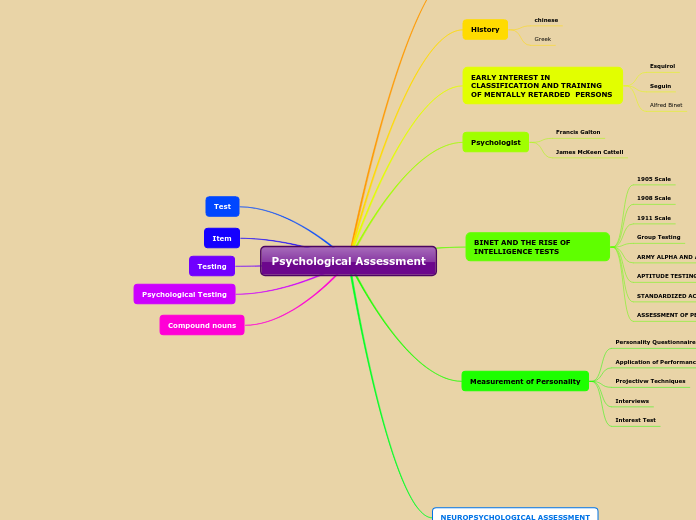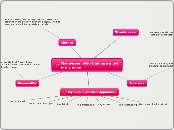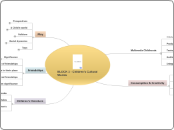Psychological Disorders
Texto sugerido1Texto sugerido2
Personality Disorders
People with personality disorders exhibit a personality style that differs markedly from the expectations of their culture, is pervasive and inflexible, begins in adolescence or early adulthood, and causes distress or impairment.
Cluster C
Disorders include avoidant personality disorder, dependent personality disorder, and obsessive-compulsive personality disorder.
People with these disorders often appear to be nervous and fearful.
Cluster B
Disorders include antisocial personality disorder, histrionic personality disorder, narcissistic personality disorder, and borderline personality disorder.
People with these disorders usually are impulsive, overly dramatic, highly emotional, and erratic.
Cluster A
Disorders include paranoid personality disorder, schizoid personality disorder, and schizotypal personality disorder.
People with these disorders display a personality style that is odd or eccentric.
Dissociative Disorders
Characterized by an individual becoming split off, or dissociated, from her core sense of self.
Memory and identity become disturbed.
These disturbances have a psychological rather than physical cause.
Dissociative Identity Disorder
Formerly called multiple personality disorder.
People with dissociative identity disorder exhibit two or more separate personalities or identities, each well-defined and distinct from one another.
About 95% of people with DID were physically and/or sexually abused as children
Derealization Disorder
Derealization: The person feels that the world surrounding them is not real.
Depersonalization Disorder
Depersonalization: The person believes his/her movements, thoughts and feelings are not their own.
Dissociative Amnesia
The individual is unable to recall important personal information. (They may even forget who they are and adopt another identity for a few hours or days)
It usually follows an extremely stressful or traumatic experience such as combat, natural disasters, or being the victim of violence.
Psychotic Disorders
Schizophrenia
Is considered a psychotic disorder - the person’s thoughts, perceptions, and behaviors are impaired to the point where he/she is not able to function normally in life.
Causes:
Both genetic vulnerability and environmental stress are necessary for schizophrenia to develop.
Obstetric complications. (That affect brain development)
Another variable that is linked to schizophrenia is marijuana use. Longitudinal studies have suggested that marijuana use is, in fact, a risk factor for schizophrenia.
+Hallucination: a perceptual experience that occurs in the absence of external stimulation.
+Delusions: beliefs that are contrary to reality and are firmly held even in the face of contradictory evidence (paranoid, grandiose or somatic).
+Disorganized thinking: incoherent thought processes.
+Disorganized or abnormal motor behavior: unusual behaviors and movements (very active or catatonic).
+Negative symptoms: noticeable decreases and absences in certain behaviors, emotions, or drives.
Mood Disorders
Mood disorders are characterized by massive disruptions in mood.
Extreme sadness and hopelessness of depression to the extreme elation and irritability of mania.
Types of mood disorders:
Bipolar Disorder
The person often experiences mood states that vacillate between depression and mania.
A manic episode is characterized as a “distinct period of abnormally and persistently elevated, expansive, or irritable mood and abnormally and persistently increased activity or energy lasting at least one week,” that lasts most of the time each day.
+Mood that is almost euphoric.
+Excessively talkative.
+Spontaneously starting conversations with strangers.
+Excessively irritable.
+Abruptly switching from one topic to another.
+May exhibit grandiosity.
+Engage in recklessly pleasure activities that could have harmful consequences. (Gambling, reckless driving, etc.)
Subtypes of depression
Persistent depressive disorder
Depressed moods most of the day nearly every day for at least two years, as well as at least two of the other symptoms.
Postpartum depression
Is a complex mix of physical, emotional, and behavioral changes that happen in some women after giving birth.
+Trouble sleeping
+Appetite changes
+Severe fatigue
+Lower libido
+Frequent mood changes
Seasonal pattern
Exists when a series is influenced by seasonal factors (e.g., the quarter of the year, the month, or day of the week). Seasonality is always of a fixed and known period. Hence, seasonal time series are sometimes called periodic time series.
Major Depressive Disorder
Most people recover from Major Depression within a year but their chances to get another episode increase each time they have one.
It is more common
among women than
among men, affecting
approximately 20% of
women and 13% of men
at some point in their life.
To receive a diagnosis of major depressive disorder, one must experience at least five symptoms for at least a two-week period.
+Significant weight loss (when not dieting) or weight gain and/or significant decrease or increase in appetite;
+Difficulty falling asleep or sleeping too much;
+Psychomotor agitation or psychomotor retardation;
+Fatigue or loss of energy;
+Feelings of worthlessness or guilt;
+Difficulty concentrating and indecisiveness; and
+Suicidal ideation or attempt.
+Depressed mood most of the day, nearly every day (feeling sad, empty, hopeless, or appearing tearful to others)
+Loss of interest and pleasure in usual activities.
+Feeling overwhelmingly sad most of each day.
+No interest or enjoyment in activities that previously were gratifying, such as hobbies, sports, sex, social events, time spent with family, and so on.
Trauma and Stress Disorders
Posttraumatic Stress Disorder
Extremely stressful or traumatic events, such as combat, natural disasters, and terrorist attacks, place the people who experience them at an increased risk for developing psychological disorders such as posttraumatic stress disorder (PTSD).
Obsessive Compulsive and Related Disorders
Causes of OCD and related disorders:
The disorder is five times more frequent in the first-degree relatives of people with OCD than in people without the disorder.
The concordance
rate of OCD among
identical twins is
around 57%.
Hoarding Disorders
People with hoarding disorder cannot get rid of personal possessions, regardless of how valueless or useless these possessions are.
Body Dysmorphic
The person is preoccupied with a perceived flaw in their physical appearance that is either nonexistent or barely noticeable to other people.
The person engages in repetitive and ritualistic behavioral and mental acts, such as constantly looking in the mirror, trying to hide the offending body part, comparisons with others, and, in some extreme cases, cosmetic surgery.
OCD
People with this disorder experience thoughts and urges that are intrusive and unwanted (obsessions) and/or the need to engage in repetitive behaviors or mental acts (compulsions).
We all have unpleasant thoughts and repetitive behaviors from time to time, however, obsessive-compulsive and related disorders elevate the unwanted thoughts and repetitive behaviors to a status so intense that these cognitions and activities disrupt daily life.
repetitive behaviors
unpleasant thoughts
Involve intrusive
Anxiety Disorders
Are the most frequently occurring class of mental disorders and are often comorbid with each other and with other mental disorders. Approximately 25%–30% of the U.S. population meets the criteria for at least one anxiety disorder during their lifetime.
Generalized Anxiety Disorder
Is a relatively continuous state of excessive, uncontrollable, and pointless worry and apprehension.
Worry about routine, everyday things, even though their concerns are unjustified.
Panic Disorder
Imagine that you are at the mall one day with your friends and—suddenly and inexplicably—you begin sweating and trembling, your heart starts pounding, you have trouble breathing, and you start to feel dizzy and nauseous. This episode lasts for 10 minutes and is terrifying because you start to think that you are going to die.
Nausea
Abdominal Distress
Chest pain
Palpitations
Accelerated heart race
Feeling dizzy
Usteady
Lightheaded
Social Anxiety
Formerly called social phobias
Is characterized by extreme and persistent fear or anxiety and avoidance of social situations in which the person could potentially be evaluated negatively by others
Phobias
In México the 5 most common phobias are:
Claustrofobia
Agorafobia
Aerofobia
Fobia social
Aracnofobia
Symptoms:
Persistent fear caused by the presence or anticipation of a specific object or situation.
Unreasonable
Intense









